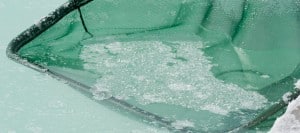SALT FROM SALIES-DE-BEARN
At the saline of Salies-de-Béarn, rock salt or mineral salt is derived from very old salt layers that reside in the depths of the Pyrenees.
This salt has always been collected according to a traditional method. The heated water evaporates and in good weather, the salt crystallizes forming coarse grains. Harvested by a simple dip net, the first crystallization gives birth to salt petals of a whiteness and incomparable lightness.
The petals then turn into large crystals and settle in the pan. This salt is so pure, that is does not need to be washed or require any treatment. Once the salt is harvested, the mineral water it leaves is rich in trace elements. This exceptional quality contributes to the reputation of the saline of Salies-de-Béarn.
The gentle evaporation of the spring water makes it possible to obtain a salt of a natural whiteness. And this, without any treatment or additives.
To our knowledge the Saline de Salies-de-Béarn is the only one in Europe that perpetuates this mode of production for salt sourcing using evaporation of water in salt pans.
Salt benefits
A spring water with exceptional qualities
The shape of the crystals is characteristic of each salt and its method of production. Salt crystals of Salies de Béarn have the shape of whole hollow pyramids, more or less broken or agglomerated.
But the particularity of Salies-de-Béarn salt lies in its fluid inclusions. They are formed because of the irregular arrangement of the chloride and sodium atoms that form during crystallization of the salt. These small cavities are filled with concentrated spring water that remains trapped in the salt crystals
The millennial salt of Salies-de-Béarn comes from huge underground aquifers full of marine salt water, naturally rich in trace elements such as magnesium, calcium and iron. Because salt comes from this material, these waters are called « mother liquors ». They have great medicinal value for care in rheumatology, gynecology and pediatrics.
Beyond its remarkable concentration of sodium chloride, the water of the Reine Jeanne d’Oraas spring contains in total more than 26 minerals and trace elements.
In 1 liter of water can be found:
– More than 300 g of sodium chloride
– 1500 mg of potassium
– 1300 mg of calcium
– 700 mg of magnesium
– 11 mg of iron
– 3 mg of manganese
– 1.3 mg of zinc
Since the 19th century the salty spring water of the province of Salies de Béarn has been used for its health benefits and medicinal properties.
Salt is life
«One of the reasons that salt is a preferred substance is probably that a small amount is used to determine great effects»
Gaston Bachelard, philosopher
The Salies-de-Béarn salt contains many minerals and has great dietary and therapeutic qualities.
The basic minimum to cover our basic needs is 1 to 2 grams per day and normal and sufficient daily intake in humans is 3 to 6 grams.
Salt consumption:
– measure the right dose: neither too much nor too little is essential
– do not salt everything in the same way
– use a quality salt
– learn to taste before salting
Salt allows our body to retain water in our body. Sodium, a nutrient derived from ingested salt, plays an important role in the transmission of nerve impulses. This has an influence on the blood pressure and plays an important role in the hydration of the body. It contributes to the contraction of the muscles especially those of the heart. Chloride is essential to ensure the acidity of gastric juice and facilitates digestion.
Salt, a story of taste
« Salt is a food that embellishes other foods. Of the necessary food, it makes a pleasant food. »
Plutarque, Table
Salt sharpens the taste of the product we eat. It raises the dishes and reveals the aromas. Salt is one of four basic taste sensations such as sweet, sour and bitter.
Salt conservation: a major role
Since the end of the prehistoric age, salt is the oldest ingredient used for food preservation and today salt is an essential element for health security.
The salt room once played a domestic role comparable to that of the freezer in our society. Salt was used to make canned goods in large terracotta earthenware such as the famous Gallic hams that traveled all over Europe. Many foods derive their names from the word salt: salted, salted, sausage…
Salting is a key stage in cheese making. Salt acts as a flavoring and preservative agent. It naturally absorbs moisture and ensures the transition between dripping and ripening. It is used to release the whey and thus helps stabilize the shape of the cheese. For each cheese, we choose a quality of salt. The salt of Salies-de-Béarn is mainly used for making the famous cheeses of the Pyrenees.
Salt and salting, the historic union
For the dry salting technique of the famous Bayonne Hams, salt from Salies-de-Béarn is traditionally used. Fresh whole hams are rubbed and covered with a thick layer of salt before being placed in the salt pan.
To favor the flavor of the ham, it is essential to use a pure salt, very rich in mineral salts and trace elements. Bactericidal, the salt of Salies-de-Béarn has a very high penetration capacity that allows during the ripening period to obtain a soft and naturally pink flesh.




